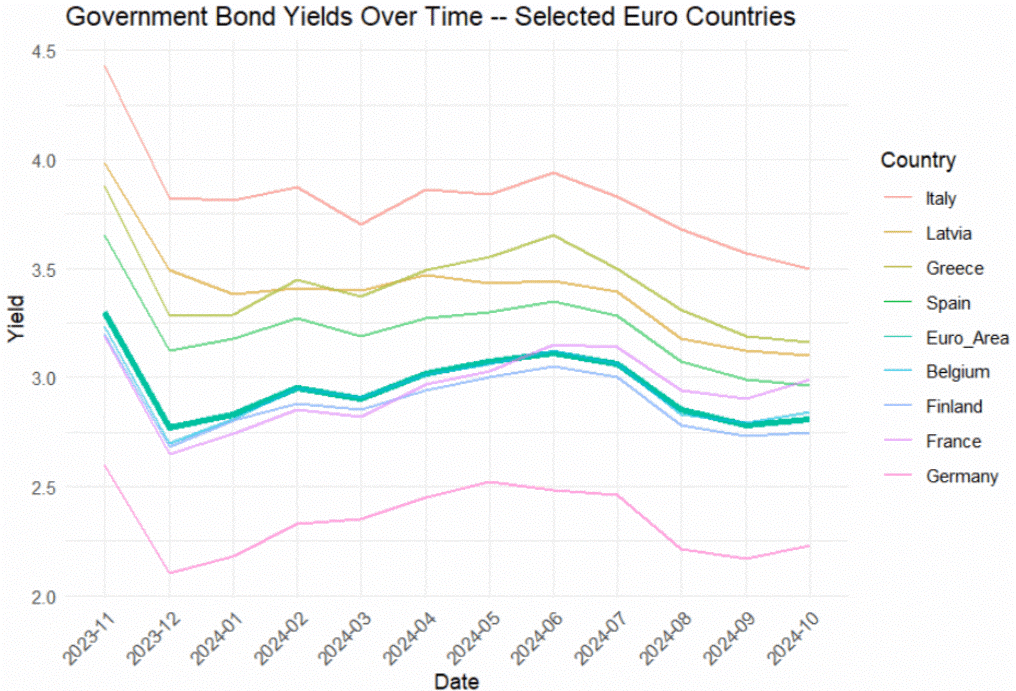
Fueled by rampant geopolitical uncertainty, sovereign risk is on the rise in Europe. Policymakers and regulators, however, continue to assign a zero-risk weight to sovereign debt issued by any EU country.
Earlier this month, the full rules of the Capital Requirements Regulation 3 (CRR3) – the EU’s customized version of Basel III – were scheduled to go into effect. Strangely, though, government bonds remain risk-free (zero-risk weight) under this updated regulatory regime.
In its recently published Financial Stability Review (FSR), the European Central Bank (ECB) asks EU financial institutions to pay special attention to “sovereign vulnerabilities,” emphasizing that “fiscal challenges persist in several euro-area countries.” Geopolitical volatility across Europe – in the form of the Russia/Ukraine war, increasing cyberattacks, climate and environmental threats, and proposed tariffs that could hamper international trade – is certainly one of the key factors the ECB was alluding to in its sovereign debt warning.
Marco Folpmers
The supervisor also points out that some eurozone countries suffer from the twin devils of a high consolidated government debt level and a current budget deficit. For these countries, once a crisis hits, it will be difficult to apply the Keynesian remedy – i.e., to spend themselves out of a downturn with the help of fiscal measures designed to stimulate the economy.
To better understand why it would make sense for supervisors to assign a higher risk weight to European sovereign debt, we need to first explain the existing government bonds picture, and then examine projections for these instruments.
Interestingly, the ECB report shows that the yields on government bonds within the eurozone are expected to increase during the coming years. Spreads against German government bonds (with low yields), for example, are expected to increase for Italy, France and several other European countries. (See chart 1.3.b in the ECB’s report.)
Since these are projections, the increasing spreads are not simple measurements. The ECB says these forecasts depend on “a range of fiscal and macro-financial assumptions, including no-policy change on the fiscal side, EU commonly agreed methodology for long-term economic growth, and market-based interest rate projections.” This is a convoluted way of saying that geopolitical uncertainty is increasing and that spreads within the EU are expected to further diverge.
The degree of this projected divergence, however, remains to be seen.
Forecast: Volatile and High Spreads
While it’s difficult to verify the data underpinning the ECB’s sovereign debt warning, we can analyze the recent history of government bond spreads in Europe.
Figure 1 below depicts long-term government bond yields, across selected euro zone countries, for bonds with a remaining maturity of 10 years. The figure uses Eurostat data from November 2023 to October 2024.
Figure 1: Government Bond Yields

Source: Eurostat
The curves in Figure 1 show a slightly nuanced picture. Diverging spreads are not detectable in the past year’s yield data. On the contrary, the series follow a highly correlated pattern. We do see, however, that yields can be wide apart (easily more than 100 basis points) and that the spreads, vis-à-vis the German yields, are quite stable over the past 12 months.
It will be interesting to examine this dataset in the future to see if ECB expectations regarding diverging sovereign vulnerabilities indeed come to fruition. France should be a particularly fascinating case study.
Last December, Moody’s downgraded France’s sovereign debt from Aa2 to Aa3, causing a big swing in credit-default swap prices. France’s unstable government, with its revolving door of prime ministers, was likely a reason for the downgrade. A bigger problem, however, may be that France’s debt-to-GDP ratio has risen from 98% to roughly 112% over the past five years.
Zero Reason for Zero Weight
The difficulty with volatile sovereign risk is that, in an extreme case, market yields will spin out of control once a vicious cycle is entered. Such a cycle may look like this: (1) sovereign debt gets downgraded by the rating agencies due to perceived increase in risk; (2) the sovereign’s PD increases as calculated by its main counterparties; (3) the CDS swap price increases accordingly, as well as the bond’s yield; (4) the interest rate for refinancing the country’s debt increases; (5) the country’s debt service coverage ratio further decreases; and (6) further downgrades may apply, leading us back to stage 1.
Market equilibrium for the yield cannot be found during such a vicious cycle. Indeed, under these circumstances, a country’s finances can ultimately be repaired only after external parties step in with guarantees and bail-out arrangements.
Despite the evidence of increasing sovereign debt risk in Europe, fueled by geopolitical uncertainty, EU policymakers and supervisors have continued to stick with the zero-risk weight. As we have mentioned, the zero risk weighting scheme for EU member state debt remains unchanged under CRR3.
Zero weighting leads to banks accumulating EU member state debt, creating a mutual dependency between banks and sovereign debt issuers. This relationship can turn dangerous, particularly after the start of an economic crisis, and is therefore known as “the deadly embrace.”
The risks of this mutual dependency were substantiated in an article authored by a trio of academics last year. The authors of that piece also contend that zero-risk weight is even harmful during a benign economic environment, since the relative mispricing of the sovereign risk leads to distortions in optimal capital allocation by providing an incentive for banks to hold sovereign debt rather than private capital.
Parting Thoughts
During the 2009-10 sovereign debt crisis, Willem Buiter, Citi's chief economist at the time, said: “There is no such thing as an absolutely safe sovereign.” That statement continues to ring true.
In its Financial Stability Report, the ECB conceded that government debt carries risk and explained that these risks are increasing for countries such as France and Italy. Indeed, France’s recent turmoil illustrated that sovereign credit risk is both non-zero and volatile. Academic evidence continues to accumulate, moreover, that the zero weighting is not beneficial for the capital allocation within society.
It is therefore baffling that the final version of CRR3 continues to assign a zero-risk weight to sovereign debt.
Dr. Marco Folpmers (FRM) is a partner for Financial Risk Management at Deloitte the Netherlands.
Topics: Default